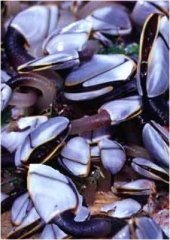
We get the name goose barnacle, because it resembles a goose's head and neck.
This odd looking barnacle is normally found in quite deep waters around our coasts, but occasionally they can be found washed up on our Eastern, but more commonly our Western beaches. Normally found on debris that has become dislodged from the sea bed or man made structures such as rope, bouys, drift wood and on the hulls of many large ships.
The goose barnacle is a heart shaped chalkey white shell. It has large shell plates and edged with brown or black and yellow lines.
They are attached to these surfaces by a long flexible leathery stalk about 3.5cm or 1.5" long. The plates of the head are held together by a simIlar leathery skin. They are unable to move from the point they are fixed to. These heads have five plates or shells that protect the body and feathery limbs called 'cirri'.
They are not only found around New Zealand, but are also found in most of the worlds oceans except the Arctic areas.
Goose barnacles feed on plankton and small crustaceans.
When feeding, the barnacle extends its cirri (fan like array of limbs) in order to catch plankton. They use them to push water and food towards their mouth.
Like some other marine life Goose barnacles are hermaphrodites (meaning that the animal has both male and female sexual organs). Larvae more closely resemble other crustaceans except for their long feathery legs.
When the eggs hatch they become free swimming larve which drift in the oceans currents and soon metamorphose into a form which attaches itself to a suitable surface and becomes a barnacle.
Once they have attached themselves to an object, they do not move again unless torn off by accident. As they grow they develop a feathery feeding apparatus, which filters particles of food from the water as the current passes over it. This filter can be speedily withdrawn inside the hard capitulum when the barnacle feels threatened.